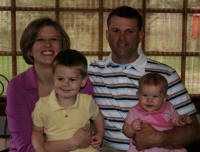 Justin works for the Department of Corrections at the Lincoln
Correctional Center. Justin works for the Department of Corrections at the Lincoln
Correctional Center.
They had the classic two children, one of each, as they continued
their careers and their lives together.
The Browns live in a nice split-level home on a quiet street on
the west side of Lincoln, and for them the journey was as normal and
average as any middle-class American family. It was until ALS;
Michelle's constant companion entered their lives last May.
ALS, amyotrophic
lateral sclerosis, is a neuro-degenerative disease that usually
attacks both upper and lower motor neurons and causes degeneration
throughout the brain and spinal cord. A common first symptom is a
painless weakness in a hand, foot, arm or leg. Other early symptoms
include difficulty with speech, swallowing or walking. --
ALS Association

The first symptom Michelle noticed was a slight drop with her
left foot. "I would be walking, and my foot would get caught," she
said. "It was intermittent, and I went to the doctor, who didn't
think at the time it was anything serious." As the problems
persisted, Michelle saw a Springfield neurologist, who thought it
was a pinched nerve and prescribed physical therapy, but the
problems continued and then began to get worse.
By November, Justin observed the fact that something was
seriously wrong with Michelle. "I noticed her speech, her response
time and her balance was getting worse," he said.
Michelle also was becoming alarmed at what was happening to her.
"It became difficult to hold a pen or tie my shoes," she said. "I
had a coordination problem and found it was difficult to clap my
hands together."

Michelle and Justin decided they needed to go to St. Louis to see
a specialist. It was at their second visit with this doctor that
they were given the news that Michelle did in fact have Lou Gehrig's
disease. When asked the date, without a moment's pause they both
answered: Dec. 17. In January, a visit to the Mayo Clinic confirmed
that Michelle had this uncommon, but not rare, sickness.
The biological
mechanisms that cause ALS are only partially understood. The only
known cause of ALS is a mutation of a specific gene, the SOD1 gene.
This mutation is believed to make a defective protein that is toxic
to motor nerve cells. The greatest occurrence of ALS, which afflicts
as many as 30,000 individuals at any given time, is primarily random
and can strike anyone at anytime. --
ALS Association

"If I were going to be sick, why couldn't it be something I could
fight and win? The Mayo Clinic told us there was no treatment for
ALS. Instead they tell you how you are going to die," Michelle said.
Michelle admitted that she had feared all along that she might be
the exception to a rule no one cares to become a part of. She was
only 30 years old, with two little babies. ALS usually strikes
individuals in their 40s or older. Her continuing Internet study of
the disease and its onset of symptoms had given rise to a fear that
she was now being told was reality.
During the interview Michelle apologized for the scrapes on her
face. "I'm afraid I fell," she said. "And I can't use my hands to
break the fall. Once I'm down, I need help getting back up.
Sometimes I can use the couch to help me get off the floor."
Both Michelle and Justin were frustrated that there was nothing
they could do to fight the disease. No one was offering them any
hope. Currently the only FDA-approved drug to combat ALS is Rilutek,
which only prolongs life three to four months.
[to top of second column]
 |

There were no options being offered the Browns in the U.S. "There
are some clinical studies going on, but that won't help. What if I'm
one of those who are given the placebo?" Michelle asked that
question with her curled hands resting on her lap. The fingers
appear to be drawing in on each other as one would see with an
elderly person suffering from severe arthritis.
Michelle and Justin continued speaking about their frustration
with the lack of possible alternative medical treatment in our
country. They knew they couldn't give up without a fight. And so,
they went to Mexico, where stem cell therapy is legal.

In the small town of Los Algodones, Michelle was treated by a
doctor with an injection of lamb stem cells into her bloodstream,
but the treatment did nothing to cure or slow down the debilitating
disease.
Further research and discussions by the Browns with other ALS
sufferers revealed a U.S. firm that is working with using stem cells
derived from umbilical cords to treat neurological disorders such as
ALS. Again, this procedure is not approved in the U.S., so they will
be going to a clinic in Zonto Rio, Mexico, later this month. Of
course, the treatment will not be covered by their family's
insurance carrier.

While there, Michelle will receive a massive, 300 million stem
cell injection into her spinal column. The results of this treatment
have been mixed, with no outright claims of cures being made. But it
is a hope, as some ALS sufferers have shown some improvement. Others
have reported the disease's mad dash through the body seemed to have
slowed.
"I think people with ALS will try anything. It is important to at
least have an option, even if it is a very remote option. I have to
have something. I have to have hope. I can't just accept I get to
die and that's it. I couldn't imagine going through this without the
support I have from my family and our friends," Michelle said.
During the night's conversation, as son Avery rode his tricycle
around the yard, little Nora flitted in and out of the room, giving
brief yet welcomed respites from the topic at hand. She took turns
moving from Dad's to Mom's lap as if she didn't want to hurt either
parent's feelings by not sharing her love. As she sat on Michelle's
lap, her hugs were returned by her mother. They were more of a hug
with Michelle's arms than her hands, which don't have the strength
they once did. It didn't matter to the little girl. The love, the
bond, between all the Brown family couldn't be stronger.
Both Michelle and Justin talked about how amazed they are by the
support of not only those closest to them, but the community in
general. Justin said he hopes the fundraiser Friday and Michelle's
story will help make people more aware of ALS and support funding to
find a cure.

"I do appreciate everyone's help. I know everyone is busy and
life goes on," Michelle said. We all hope that for a long time to
come the Brown family will be able to continue to say just that.
For complete information on the Michelle Conrady-Brown
fundraiser, which will be on Friday at the Knights of Columbus Hall,
readers can go to
www.jamcreatinghope.net.
[By MIKE FAK]
Related commentary
|